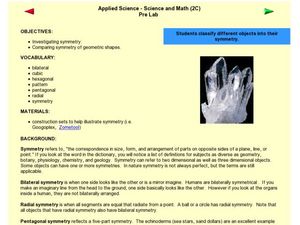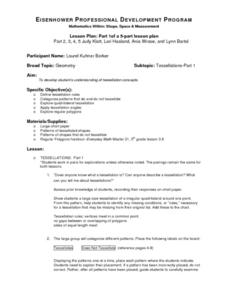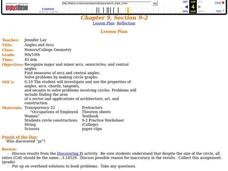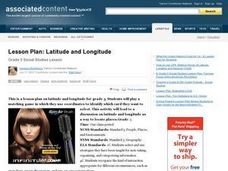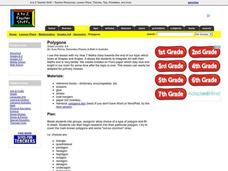Curated OER
The Shadow Knows
Sixth graders examine the relationship between light and the angle it strikes objects. In groups, they shine light from a flashlight on different objects and describe how it affects the shadow. To end the lesson, they complete a...
Curated OER
Angles and Parallel Lines
Sixth graders draw parallel and intersecting lines to observe and examine the characteristics of alternate interior angles, vertical angles, corresponding angles, and supplementary angles. Through observation, they discover the...
Curated OER
Polygons and Angles
Sixth graders estimate the measurement of angles and then measure the exact distance using an angle ruler. In groups, they explore shapes and recognize the characteristics acute, obtuse and right angles. Students sketch required shapes,...
Curated OER
Symmetry
Sixth graders explore symmetry and discuss the difference between a rotation and reflection. Using hands-on activities, such as folding paper shapes, they discover how to find the lines of symmetry and symmetrical characteristics. As a...
Curated OER
Back to the Bees (Tesselations)
Sixth graders observe the creation of a tessellation with hexagons. In groups, they work with polygons to discover what shapes can be used to create tessellations and explore the angle measurements of each shape. Using internet websites,...
Curated OER
Angle Benchmarks
Sixth graders discuss the characteristics of specific angles and then use the information to to identify and estimate given angles. The class goes outside, identifies north, and turns a specified amount of degrees. Using a given compass,...
Curated OER
Geometry /Tessellations
Students investigate the concept of tessellations and how they are formed using angles. They categorize how different patterns do and not tessellate and separate them into two different places for assessment. The teacher draws examples...
Curated OER
Quilt Patch Proof
Students construct a convincing argument that the same amount of fabric is needed for each color of quilt being made in a specific design. They justify the relationship between vertical angles and the sum of the interior angles. Students
Curated OER
BASEBALL HOME RUN
Students determine whether a hit baseball is a home run or not by utilizing parametric equations to describe the path of the ball. They assess the importance of angles and velocity needed to hit a home run. In addition, in their own...
Curated OER
Exploring Geometric Patterns and Relationships
Sixth graders explore different geographic relationships in like drawing lines, rays, and parallelograms. This lesson could be used for review because it covers more than one concept. The students should have prior knowledge.
Curated OER
Geometry: Lesson 1: Points, Lines, Segments, Angles
Fourth graders examine the concepts of, draw, and label points, lines, segments, and angles, They draw, label, and identify horizontal, vertical, intersecting, parallel, and perpendicular lines. They complete an associated worksheet that...
Curated OER
Identifying Angles
After identifying angles (acute, obtuse, right) during a math or science lesson, 4th graders will use the computer to stamp pictures in the correct category using KidPix computer software.
Curated OER
Angle Pairs
Students practice identifying right, vertical, and adjacent angles using a Smartboard. They then determine measurements of all of the angles when only one measurement is given.
Curated OER
Measuring Angles
Third graders describe an amount of turn from a particular position to another using the 'circular' benchmarks of 0, ++, ++, ++, and full turn. Estimation language such as 'just about', 'between', 'not quite', 'just over', and similar...
Curated OER
Dizzy Heights
Fifth graders explore ways to measure the height of an inaccessible object. They measure lengths using a tape measure or ruler. Students measure angles using a protractor and estimate heights.
Curated OER
Angles in Art Lesson
Students examine the correlation between art and math. Using their computers, students construct and measure angles. Students identify the properties of angles and polygons. They engage in the Angles program on their Palm and use the...
Curated OER
Angles and Arcs
Students discuss the sum of central angles and use string to create them on circles. They find the measure and length of both minor and major arcs.
Students give examples of concentric, similar, and congruent circles and congruent arcs.
Curated OER
Latitude and Longitude
Students identify latitude, longitude, prime meridian, international date line, and equator. They compute the latitude and longitude of different objects.
Curated OER
Watch It Slide!
Students work together to examine inclined planes. They create a plan to raise rocks to build pyramids. They discover the changes that occur when the angle is increased or decreased.
Curated OER
Origami Frogs
Ninth graders explore a variety of geometry and science concept while making an origami frog. The fold paper into the shape of a frog and conduct measurement activities including frog leaps.
Curated OER
Polygons
Learners work together to create mobiles with different polygons. They research the polygon and list its characteristics. They may present to the class if they chose to.
Curated OER
Learning Lesson: Moonlight Serenade
Students complete experiments as they act as the earth. They observe how different angles affect the phases of the moon seen by us. They discuss the differences in light and dark.
Curated OER
Reflection of Light With Two Plane Mirrors- Double Mirrors Placed at a Number of Angles
Students place two plane mirrors at different angles to experiment with reflection. They make kaleidoscopes and periscopes.
Curated OER
Geometry on a Grand Scalle
Pupils, in groups, construct different angles and shapes on a large scale using string and chalk.





